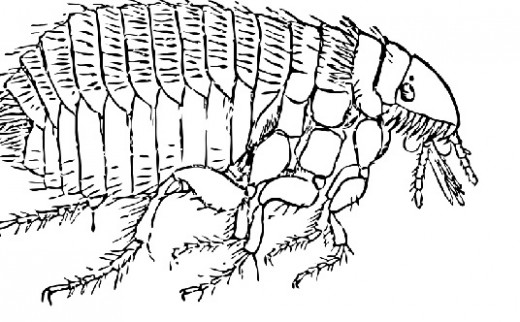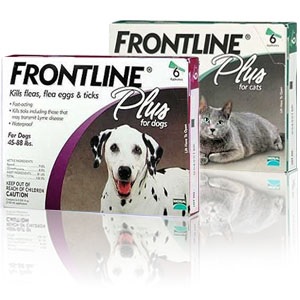- HubPages»
- Pets and Animals»
- Dogs & Dog Breeds»
- Dog Health
Prevention and Treatment of Fleas, Ticks, Tapeworms, and Mites

Tick Season
Ticks can be found anywhere, but are especially prevalent in tall grass and wooded areas. Ticks are most common in the summer months, however, they can be found as early as April. The first step to preventing fleas and ticks on your family pets is to use preventative flea and tick medication which can easily be procured online, from your vet, or at your local pet store.
There is still a small chance that your animal may pick up a tick somewhere along the way even after taking preventative measures. There are controversial ways on how to remove a tick. Some people try to burn a tick to force it to 'back out'. Others poke it with a hot needle to. Some twist and agitate the tick so that it will back away on its own. This is advised against, as this will actually encourage the tick to release more saliva and cause infection. So what is the vet-recommended way to remove a tick?
1.) Safety First. Equip yourself with a pair of gloves to avoid coming in contact with a potentially infected tick.
2.) Using tweezers, grab the tick's mouth parts. Do not squeeze the tick's body at any point, as this will squeeze out more of the tick's saliva into your animal. Firmly, without jerking, pull the tick out.
3.) To dispose of the tick, drop it in a jar of alcohol to kill it instantly. If you do not have alcohol, burn the tick with a lighter or some other source until it dies. It is recommended to have your dog tested for Lyme disease afterwards.
4.) It's always a good idea to clean the bite wound with disinfectant, followed by an application of pet-safe antibiotic medication.
Ticks are gross to deal with, especially if you are squeamish around parasites. If you are a new pet owner or do not feel comfortable removing the tick, ask your local veterinarian. If you are not confident that you can remove the tick correctly, your veterinarian should be more than willing to teach you.
Remember, the key step is prevention.
Good Luck!
How to Properly Remove a Tick
Removing a Tick: Test your Knowledge!
view quiz statisticsMites: The Bad and the Ugly!
There are several types of Mites which can affect you and your pets. These parasites can cause a lot of damage and irritation. The 3 best known types include: Ear mites, demodex, and sarcoptic mites.
Ear mites are relatively easy to diagnose. Symptoms include shaking of the head and excessive itching/scratching. Mites thrive on the climate inside your pets' ears. Although some animals build up earwax naturally, excessive build up of darker earwax indicates the likelihood of ear mites. If left untreated, there may be bleeding, hearing impairment, and in extreme cases, convulsions or death. Clean all bedding and bathe your pet. Ear drops will keep your dog's ears clean. A healthy ear is a happy ear!
Demodex mites live deep in hair follicles. In small numbers they are not harmful. However, when mites overtake the animal, lesions and hair loss will occur, and develop into a condition called demodicosis, or red mange. An animal with a healthy immune system should not be affected by demodex. Demodex is a species-specific parasite and will be passed from dog to dog, and not humans.
Sarcoptic mites cause Sarcoptic mange, which is much more highly contagious than demodex mites. Scabies are a burrowing mite which can affect any human or animal. They quickly cause infection, major hairloss, and injury from scratching and biting. To treat mites, a special sulfur topical treatment is required from your local vet.
Clean everything and medicate as soon as possible if there are mites in your dwelling. If you suspect your pet has mites, please contact your local veterinarian as soon as possible.
There are many medical issues which most owners will face at some point or another. Dealing with these issues can be frustrating and costly. Recognizing differences in your pet's behavior can help prevent these problems from worsening.

Fleas: Nature's vampires
Fleas are probably one of the most dreadful external parasites to get rid of. They are hard to see, they are very irritating, and they can multiply out of control. Prevention is key. However, if you find yourself with a flea infestation, there are a few things you should know and a few steps to ridding your household and your pets of these parasites.
Fleas suck blood, they're fast, they jump, they get into the carpet, and they can be extremely hard to kill. In fact, bombing your house may not always do the trick (Been there, done that). Sprinkling borax or other powders may slow them down as you try to suck them up with a vacuum. Washing all of your bedding, pet's bedding, anything that is exposed is a start...
But none of that is worth it until you've killed them at the source. Most likely if you have fleas, they are attracted to your pet. Flea baths could be an answer, but sometimes even this does not kill all of the eggs lurking in your pet's fur. Using flea preventative is a great way to be rid of these pesky parasites. Monthly flea and tick preventative goes into your pet's bloodstream. When the fleas bite, they are poisoned and die. When the eggs hatch a couple weeks later, they bite and die as well. The only way to truly be rid of these parasites is to have continuous flea and tick preventative care.
*For further reading about the effectiveness of flea prevention, I have listed empirical resources at the end of this article.
You will notice that the preventative will help get things under control. It's also important to bathe your pet (not for at least a couple days after administering the preventative drops), to try to rid of any leftover or dead fleas, flea eggs, and so forth.
Be wary of flea shampoo. Some of these can be very toxic and irritating to your dog's skin. Research your brands or ask your vet for some suggestions.
After bathing, vacuuming, sweeping, countless loads of laundry, and so-forth, hopefully the majority of the fleas will be gone.
To add injury to insult, fleas are not the only parasite you have to worry about now! Fleas have a high potential of carrying tapeworms. If your pet ingests an infected flea, they will most likely get tapeworm as well.
The Tapeworm Lifecycle
Tapeworms
How do we get rid of tapeworms?
Your vet may require you to have a fecal sample tested. You will notice light-colored, rice-shaped worms in your pet's stool. If this is the case, your vet will need to administer a one-time pill to get rid of the tapeworm. During this period, be sure to completely dispose of all stool for the next couple of weeks and inspect it to see if the tapeworms are gone or if the pet has managed to re-infect themselves.
Many people will tell you that you can only get tapeworm by eating an infected flea. However, I have found out through personal experience that if the pet eats the stool that has tapeworm hosts in it, that can re-infect your pet. Segments of a dead tapeworm will not re-infect, however, if there are eggs or larva in the stool, it is very easy to re-infect which means more medication, time, and money.
Be safe and think prevention first! In a later post I will discuss different brands of preventatives, their effectiveness, and how to choose based on what region you live in and different chemical compounds in flea/tick preventatives. Thanks for reading!
Your Opinion Counts!
Please tell us which method you find most effective for getting rid of fleas.
Choosing the right Flea and Tick Preventative for your pet
Choosing the right flea and tick preventative for your pet can be a difficult choice. Not all flea and tick preventatives are created equal. This is something that not all pet owners are aware of. I have had different opinions from different veterinarians about which preventative treatment is best. There are also certain preventatives which should be avoided entirely.
Before we get started, a noteworthy thing to consider is to not rely on flea and tick collars or shampoo as an end-all, be-all to a flea infestation. As mentioned earlier, not all flea shampoos kill eggs still embedded in your pet's fur even after a thorough washing. Consider using a flea and tick shampoo in addition to a preventative. Flea collars will deter fleas to an extent, but they are not fool-proof.
There are many comparative charts online with information about each preventative. First of all, I recommend avoiding products from Hartz. They help for approximately a week but I find the fleas soon return. I do not recommend "cheaping-out" on flea and tick medications for your pets. They typically don't last long at best, or are completely ineffective.
I have owned enough pets in my life, and long enough to be able to compile a list of what I consider the most effective flea preventative medications. My personal favorite, go-to preventative is Frontline Plus. However Advantage and Revolution are two preventatives that have also been highly recommended to me by veterinarians.
Properties of Flea & Tick Preventatives
ADVANTAGE
| FRONTLINE PLUS
| REVOLUTION
| |
|---|---|---|---|
Kills Fleas
| YES
| YES
| YES
|
Repels Fleas
| NO
| NO
| NO
|
Kills Flea Eggs & Larvae
| YES
| YES
| Prevents Development
|
Kills Ticks
| NO
| YES
| YES
|
Repels Ticks
| NO
| NO
| NO
|
Kills/Repels Mosquitoes
| NO
| YES
| NO
|
Prevents Heartworm
| NO
| NO
| YES
|
Other Parasites
| Prevents and Treats Lice
| Treats Lice and Sarcoptic Mange
| Treats Ear mites and Sarcoptic Mange
|
Safe for pregnant / nursing
| Ask your veterinarian
| YES
| YES
|
Active Ingredient
| Imidacloprid/Pyriproxyfen
| Fipronil/(S)-Methoprene
| Selamectin
|
How to Choose the right Preventative for your pet
It's not enough to go by a veterinarian's recommendation completely. I have listed the properties of three effective preventatives, the properties which I have found online at 1-800-pet meds. As you can see, each medication has a different active ingredient. Each preventative serves a unique purpose. Let's take a look at the advantages and disadvantages of each medication.
ADVANTAGE II
The additional advantages to using the advantage II brand is that it can be great for pets who are sensitive to preventative medications. These pets are less likely to have related negative reactions to a medication. It also helps prevent and treat lice, but beyond that, the advantages to this medication are few in number.
This disadvantages are quite obvious compared to the other medications. Although none of these brands actually repel ticks, this is the only one which will not kill them when the ticks do bite. It can also be dangerous to females who are pregnant or nursing and it is advised that you speak to your veterinarian about your choices. It is advised that a secondary form of flea and tick control is used with this medication.
FRONTLINE PLUS
The additional advantages to frontline plus includes the fact that it is the only one of these three medications that will also kill mosquitoes. It also kills chewing lice and can aid with the reduction of sarcoptic mange.
There really aren't any disadvantages to frontline plus unless your pet doesn't react well to it or is not treated as effectively by it, and that is strictly on an individual basis. Compared to Revolution, this would be the ideal choice for an indoor cat.
REVOLUTION
The advantages to revolution include the fact that it is supposed to help prevent heart worm. This is the ideal medication for an outdoor cat or for a cat who lives in a region where there are a lot of fleas, ticks, and mosquitoes. Revolution should also help prevent ear mites and control sarcoptic mange infestations.
This disadvantages to revolution is that it does not kill eggs and larvae. It is supposed to prevent development, but sometimes that is not always enough. In addition, pets may be more likely to experience a negative reaction from this medication. Another thing to consider is that in most places a prescription is required for this medication. I had trouble finding it for a reasonable price online. It may also be procured through your local veterinarian.
To sum it all up....
Advantage is good for sensitive pets in addition to a secondary form of prevention.
Frontline is good for your typical indoor pet. It is also good for an outdoor pet but with additional protection for heartworm.
Revolution is good for an outdoor pet.

Flea & Tick Preventatives: Tips, Tricks, and Suggestions
1. If you do not have flea shampoo or if it irritates your dog's skin, use dawn dish soap! It effectively slows fleas down and keeps them from jumping. Thoroughly lather, scrub, and rinse your pet's coat. Follow up with flea combing to ensure they have been eliminated to the best of your ability.
I once rescued a stray kitten not more than a month old who was infested with fleas and quite anemic. He wasn't healthy enough to have a flea preventative. Dawn dish soap proved to be effective and I spent about a half hour combing through and picking off the remaining fleas before washing them down the drain.
2. When you are ready to administer preventative drops to your pet, bathe him before hand and let his coat dry before applying the topical drops. Otherwise, wait a couple of days after applying these drops to ensure it soaks into the skin completely.
3. I'll say it again. Don't "cheap out" on medications. Look for a reputable vendor or buy medications through your veterinarian. I know prevention medications are extremely costly, but I have also learned that if you go with a non-reputable vendor you will not get your money worth and you may also end up with a sick animal in the end. I try not to endorse or bash companies because it seems unprofessional, but when it comes to my pet's health I'm not shy about share my experiences about medications-gone-wrong. 1-800-pet meds has never let me down. I also know that my veterinarian's office orders preventative medications through a vendor called Merial. Unknown vendors have been known to create cheap knock-off products which may not only be ineffective, but may also make your pet sick.
Thank you for taking the time to read my article. I hope you have found this topic to be useful and I wish you and your pets all the best!
Empirical Research
For further reading, these article links explore the effectiveness of Frontline and other medications for the prevention of fleas. Scientific studies give credit to why it is so important to protect pets from parasites.
2. Efficacy of dinotefuran, permethrin and pyriproxyfen combination spot-on on dogs against Phlebotomus perniciosus and Ctenocephalides canis



